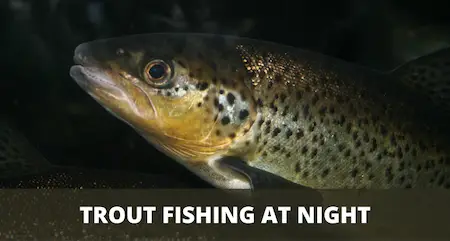How To Fish For Trout At Night (Detailed Guide)
UPDATED 03 NOVEMBER 2023
by Robert Ceran
While most trout anglers go home when the sun sets, there are a few specialists who show up around sunset.
They know how to take advantage of trout behavior at night to catch more fish during the hours of darkness than most other anglers during the day.
Night fishing for trout can be one of the best ways to catch these wily fish, but it does come with a whole additional set of challenges compared to fishing during the day.

In this article we’ll cover how to target trout at night, and will also give you our best tips on night time trout fishing.
Do trout bite at night?
Are you wondering, is trout fishing good at night? The answer is yes, trout bite at night and you can often get a better bite from them during the night than in the day.
This is especially true for brown trout, which feed very actively during the hours of darkness, but also applies to brook trout and rainbow trout (including the ones in stocked ponds).
During periods of stable high pressure weather in summertime, I’ve actually noticed that trout tend to shift to feeding almost exclusively during the night.
Another reason why trout fishing at night is such a great tactic is because you’ll increase your odds of catching trophy size fish, since the bigger trout are more active during the darkness.
Big brown trout are famous for being more active after sunset.
Best lures for trout fishing at night
The best lures for fishing for trout at night are topwater lures and spinners. Since trout key in on vibrations in the water during the darkness, it’s essential to use lures that create a lot of vibrations and sounds in the water.
Topwater lures for night time trout fishing
If you’re a bass angler, you’ll be thrilled to hear that you can use your topwater lures for night time trout fishing.
While it’s hard to get them to bite a topwater lure during the day, the situation changes completely during the night, when they will strike at big topwater lures without hesitation.
I’ve caught a 7 inch brownie on a 5 inch topwater spook, so don’t be afraid to use big lures. Here are some of the best topwater lures to try:
- Spooks: A spook is an excellent trout lure at night, since you can create a lot of commotion on the water surface by twitching your rod tip, making the spook resemble a small animal struggling in the water. Any other walk-the-dog type lure also works well.
- Poppers: Another great topwater lure that creates a lot of splashing and movement at the surface. Pause it every now and then during retrieval, since this is often the moment that trout often strike.
- Mouse imitations: Small rodents are most active at night, and therefore likely to fall into the water at night, where large trout are waiting to make a meal out of them. You’ll be surprised at how big of a lure you can use, and mouse imitation topwater lures are no exception.
Choose light colors for lures at night, such as white or yellow. Also, keep your retrieval speed as slow as possible, to give trout more time to key in on your lure.
There’s a good chance that you’ll experience a lot of short strikes, since the fish are less able to use their keen sense of vision during dark nights, resulting in less accurate strikes.
But if you pause your lure after a short strike, and give the fish another chance, you’ll often get a second or even third bite from the same fish. And with a little patience you’ll learn how to hook fish that miss your lure on the first try.
Spinning for trout at night
Another type of lure that works great for night time trout fishing are spinners. This makes perfect sense, since trout spinners create strong vibrations in the water due to their rotating blades.
Among the best spinners to choose from are the panther martin, rooster tail, and vibrax. Try to pick ones with silver or white colored blades, since these are most visible even under low light conditions.
Compared to topwater lures, spinners are better for targeting trout in deeper water, which is why you should test both types of lures until you notice which one works best on any particular night. As a good friend likes to tell me, “let the fish tell you what they want, instead of trying to tell them what they want.”
Best bait for trout fishing at night
Without a doubt, the best bait to use is live bait, since it moves around actively in the water. Keep in mind that trout rely more heavily on their lateral line organ to detect prey during darkness, and a live bait that moves around is ideal for triggering bites that way.
That being said, rainbow trout have a keen sense of smell, and you can also catch them at night with powerbait or worms. If you choose one of these baits, it really helps to add extra scents to make them more attractive to the fish.
Minnows
Small minnows are one of the best baits for trout during the hours of darkness, since they move around actively, producing vibrations underwater that attract trout in the dark.
You can rig a live minnow with a bobber rig (use a glow-in-the-dark bobber so you can detect bites at night).
In general, I find that trout feed closer to the surface during the darkness, which means you can usually target them with a live bait suspended 3 to 4 feet under a fixed bobber.
Trout fishing at night with powerbait
If you use powerbait at night, make sure to use bright colored powerbait, such as yellow and chartreuse, and remember to add plenty of extra scents to your bait.
Some of the best scents for trout are garlic and shrimp, but there are many others to experiment with.
Adding scents works during the day as well, but at night it becomes much more important, since smell becomes the main sense by which stocked trout can find your bait in the water.
Trout fishing at night with worms
When using worms at night, it’s best to use live worms, and to hook them only through one end to allow them to move around in the water.
This movement is sensed by the fish in the dark, and is more likely to trigger a bite. If the worm is big, you may want to use a rig with two hooks, so you can hook each end of the worm.
Similar to powerbait, it really helps to add some scented oils to your worm, to make them more attractive to the trout.
In addition, you should also test different depths of bait presentation, to find the one that produces most bites.
When is trout night fishing best?
The best night to go trout fishing is a dark night without moonlight, since they tend to be more active during darker nights.
During these very dark nights, trout switch from relying on their sense of vision for detecting food, and instead use their lateral line organ to sense vibrations and sounds in the water.
They are able to use this sense to key in on prey and catch it even when there is almost no light around.
This behavior of trout is different from bass, which prefer nights with lots of moonlight, and rely on their sense of vision to hunt during the hours of darkness.
So if you want to catch trout after sunset, it’s a good idea to track the moon cycle, and fish during the nights with the least moonlight.
Trout feeding behavior at night is often more aggressive than during the day, and they will strike at bigger lures during the night than during the daytime.
Trout move into shallow water at night to feed on small minnows and insects, and are less shy at this time, which means you have a better chance of catching them during the dark.
Tips for trout fishing at night
Since fishing in pitch darkness is a very different affair from regular daytime fishing, here are our best tips to help you get it right.
Use a headlamp: As already mentioned, trout tend to bite best on the darkest nights, which means you won’t be able to see very much yourself.
That’s why it’s essential to have a reliable source of light, and the best option is to use a headlamp, since that leaves your hands free for fishing.
Pro tip: Get a headlamp with a red light (or exchange the regular bulb for a red one), since red light doesn’t spook trout as much as yellow light in the dark.
Scout out your fishing spot during the day: It’s essential to have a good overview of your fishing spot, so you know how to navigate around it, and where to cast your lures or bait.
This is much easier if you’re already familiar with that location, which you can easily achieve by visiting it during the daytime just before your fishing trip. Make a note of all landmarks, as well as of the topography underwater.
Attach a singer hook to your lures: Since the accuracy of trout strikes at night is lower than during the day, you can improve your hookup ratio by adding a stinger hook to your spinner or topwater bait.
Wear a lifejacket: Wearing a floatation device is especially important if you’re going to be fishing from a boat or kayak, or if you plan to wade in a river or stream. That way you will have ease of mind, just in case you fall in the water.
Keep your valuables in a waterproof bag: In case you do take an involuntary swim, it’s best to keep your valuables in a waterproof bag to avoid ruining your smartphone or any other electronic devices that aren’t waterproof.
